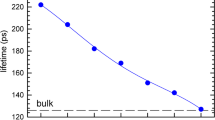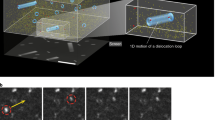Abstract
POSITRON annihilation investigations of defects in crystals have shown that for sufficiently high defect concentrations (typically above about 10−6) all positrons become trapped in the defects before annihilation, thus changing the characteristics of the annihilation process. For example, trapping of positrons may result in the increase in the positron lifetime, a narrowing of the 2-γ angular correlation distribution, and a reduction in the Doppler broadening of the annihilation line. Vacancies in metals1,2, deformation effects in metals3, and defects (F-centres or cation vacancies) in ionic crystals4 have all now been studied by this technique. The trapping of positronium (Ps) in defects in quartz5 and ice6 has also been investigated. Here we report the study of another crystal defect, the void, a small vacancy of diameter few tens of Ångstroms. In practice voids may contain gas atoms and may be disturbed either in a random fashion or arranged in a macro lattice7.
This is a preview of subscription content, access via your institution
Access options
Subscribe to this journal
Receive 51 print issues and online access
$199.00 per year
only $3.90 per issue
Buy this article
- Purchase on Springer Link
- Instant access to full article PDF
Prices may be subject to local taxes which are calculated during checkout
Similar content being viewed by others
References
McKee, B. T. A., Triftshäuser, W., and Stewart, A. T., Phys. Rev. Lett., 28, 358 (1972).
Cotterill, R. M. J., Petersen, K., Trumpy, G., and Träff, J., J. Phys., F 2, 459 (1972).
Hautojärvi, P., Tamminen, A., and Jauho, P., Phys. Rev. Lett., 24, 459 (1970).
Mallard, W. C., and Hsu, F. H., Phys. Lett., 38, A, 164 (1972).
Coussot, C., and Paulin, R., J. Appl. Phys., 43, 1325 (1972).
Eldrup, M., Mogensen, O., and Trumpy, G., J. Chem. Phys. (in the press).
Eyre, B. L., and Evans, J. H., in Voids Formed by Irradiation of Reactor Materials (edit. by Pugh, S. F., Loretto, M. H., and Norris, D. I. R.), 323 (British Nuclear Energy Society, 1971).
Goldanskii, V. J., Atom. Energ. Rev., 6, 1 (IAEA, Vienna, 1968).
McGervey, J. D., in Positron Annihilation (edit. by Stewart, A. T., and Roellig, L.), 305 (Academic Press, New York, 1967).
Gainotti, A., and Ghezzi, C., J. Phys., C 5, 779 (1972).
Author information
Authors and Affiliations
Rights and permissions
About this article
Cite this article
MOGENSEN, O., PETERSEN, K., COTTERILL, R. et al. Effect of Voids on Angular Correlation of Positron Annihilation Photons in Molybdenum. Nature 239, 98–99 (1972). https://doi.org/10.1038/239098a0
Issue Date:
DOI: https://doi.org/10.1038/239098a0
This article is cited by
-
Stem cell dynamics in Cnidaria: are there unifying principles?
Development Genes and Evolution (2013)
-
Mathematics and biology: a Kantian view on the history of pattern formation theory
Development Genes and Evolution (2011)
-
Evolving robust GP solutions for hedge fund stock selection in emerging markets
Soft Computing (2011)
-
Heads or tails: can Wnt tell which one is up?
Nature Cell Biology (2008)
Comments
By submitting a comment you agree to abide by our Terms and Community Guidelines. If you find something abusive or that does not comply with our terms or guidelines please flag it as inappropriate.



